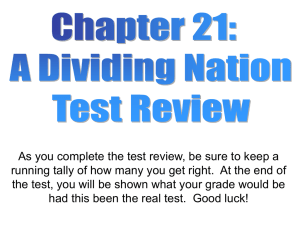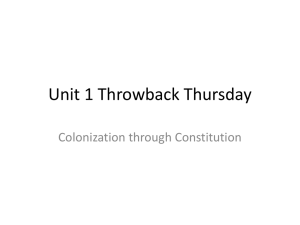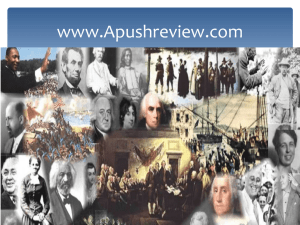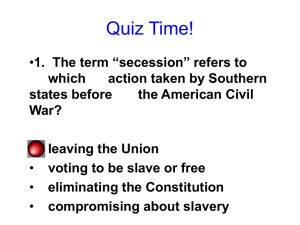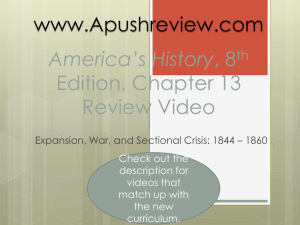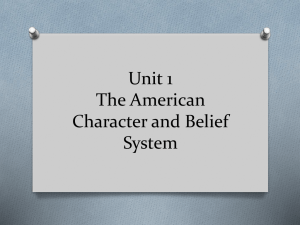US-VA midterm 2013 recorded - Mr. Bunin
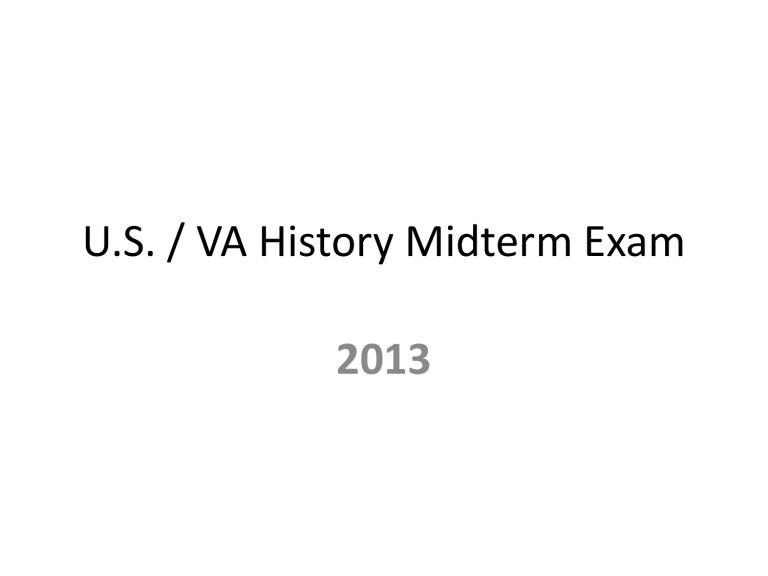
U.S. / VA History Midterm Exam
2013
1. Climatic conditions in the southern colonies most directly influenced the development of
A. democratic institutions
B. a canal system
C. the plantation system
D. the coal industry
2. Which of the following contributed to Jamestown’s eventual success?
A. Help from the Powhatan
B. Use of tobacco as a cash crop
C. Rules forcing settlers to plant food and work
D. All of the above
3. The “covenant communities” of New England were mostly based on the ideas of what document?
A. Magna Carta
B. Articles of the Confederation
C. Mayflower Compact
D. Declaration of Independence
For Questions 4-6 choose one of the following:
A. Southern Colonies B. Middle Colonies
C. New England Colonies
4. Which colonies saw the growth of America’s first cities, like Philadelphia and New York, due to their numerous harbors and were very tolerant of other religions
5. Which colonies developed a dependency on large-scale agriculture and cash crops and were settled by rich “cavaliers” who were given land grants by the British king?
6. Which colonies were dominated by Puritans and were not tolerant of other religions?
7. Conflict between the American Indians (First
Americans) and European settlers most often resulted from the different ways each culture viewed
A. Religious practice
B. Political systems
C. Land ownership
D. Family relationship
8. Slavery was introduced to the British Colonies to provide labor for
A. Plantations
B. Factories
C. Shipbuilding
D. lumbering
9. This map shows the western limit on colonial settlement that resulted from the passing of
A. Proclamation of 1763
B. Monroe Doctrine
C.
Compromise of 1850
D. Founding of Jamestown
10. Which of these completes the title for this diagram?
A. French and Indian War
B. Second Continental Congress
C. Articles of Confederation
D. Monroe Doctrine
11. In the publication Common Sense, Thomas Paine argued that
A. Foreign nations would reject an independent
American government
B. The British government would be impossible to overthrow
C. America was dependent on British trade and protection
D. The American colonies should break away from
England
12. The main purpose for writing the Declaration of
Independence was to
A. declare war on Great Britain
B. force France to support the Revolutionary War
C. convince Great Britain to abolish slavery
D. state the colonists’ reasons for separating from Great
Britain
13. George Washington was effective military commander because he
A. won more battles than he lost using well trained troops
B. preserved the army through his leadership
C. negotiated alliances with leaders of other nations
D. prevented attacks against major population centers
Use the following quote to answer question 14
14. Which nation followed this advice and allied with the colonies?
A. Austria
B. France
C. Russia
D. Spain
15. After 1763, Americans began to turn against the British because of all the following common complaints except
A. Britain sending troops to occupy the colonies
B. Britain refusing to help protect the colonies
C. the raising of taxes on many goods
D. the creation of a direct tax on legal documents, newspapers, and other paper products
16. The Boston Massacre was a response to
A. the stationing of British soldiers in Boston.
B. the dumping of British tea in Boston Harbor.
C. an editorial written by Samuel Adams.
D. the British taking over of the ship Liberty
17. The Intolerable Acts were meant to
A. take no action against the city
B. order the arrest of Mr. Allen and Mrs. Green
C. execute the people who organized the Boston Tea Party
D. punish all of Boston and all of Massachusetts for the
Boston Tea Party
18. During which event did the first fighting between redcoats and minutemen occur? It was known as the shot heard around the world.
A. Boston Massacre
B. Battle of Lexington and Concord
C. Battle of Turtle Creek
D. Battle of Bunker Hill
19. During the Revolution, the Americans had all of the following advantages over the British EXCEPT
A. they were fighting on their own land
B. more Americans supported the war
C. their troops were better trained than the British regulars
D. they had a better leader for the troops
20. These laws were known as the Coercive Acts.
They were issued in response to the Boston Tea Party and included the Quartering Act and the Tea Act.
A. Townshend Acts
B. Stamp Acts
C. Intolerable Acts
D. Proclamation Acts
21. Whose ideas did Jefferson most draw upon as he drafted the Declaration of Independence?
A. John Locke's
B. Benjamin Franklin's
C. Samuel Adams'
D. Marquis de Lafayette's
22. After the Revolution, the 13 states were first organized into a nation with a document called “The Articles of
Confederation.” What was the main problem with that system?
A. The national and state governments were equal in power.
B. The national government was too weak, and states had most of the power.
C. The national government was too strong, and states had very little power.
D. There were no state governments at all.
23. Who served as America’s representative to France during the American Revolutionary War?
A. John Adams
B. Benjamin Franklin
C. Thomas Jefferson
D. George Washington
24. Which two groups debated the ratification of the new
Constitution?
A. Loyalists and Revolutionaries
B. Federalists and Anti-Federalists
C. Democratic Party and Whig Party
D. Executive Branch and Judicial Branch
25. Which of these is NOT the name of one of the three major branches of the federal government as described in the Constitution?
A. the Judicial
B. the Legislative
C. the Bureaucracy
D. the Executive
26. He was the Father of the Constitution; was secretary of the Constitutional Convention because he took very good notes; wrote the Virginia Plan and much of the
Bill of Rights
A. Thomas Jefferson
B. George Washington
C. James Madison
D. Patrick Henry
27. A formal document that sets the baseline rules for the government.
A. Constitution
B. Bill of Rights
C. Articles of the Confederation
D. Virginia Declaration of Religious Freedom
28. This was the name of the meeting where delegates met to fix the Articles of the Confederation.
A. Federalist Meeting
B. Founding Fathers’ Convention
C. Constitutional Convention
D. First Meeting
29. They feared a powerful national government would cause the new nation to fail. They thought it would destroy the people’s rights and the rights of the different states to make their own laws.
A. Federalists
B. Anti-Federalists
C. Republicans
D. Democrats
30. What determines the number of members that each state can elect to the House of Representatives?
A. the date the state officially joined the United States
B. the land area of the state
C. the population of the state
D. all states have the same number of Representatives.
31. What determines the number of members that each state can elect to the Senate?
A. the date the state officially joined the United States
B. the land area of the state
C. the population of the state
D. All states have the same number that they can elect.
32. The Louisiana Purchase of 1803 did which of the following?
A. caused protests from the citizens of
America
B. was viewed as a waste of money
C. doubled the size of the United States
D. increased the need for a larger navy
33. Who led an expedition all the way to the Pacific coast in order to secure land and explore the Northwest Territory?
A. Thomas Jefferson and James Madison
B. Meriwether Lewis and William Clarke
C. Daniel Boone and Meriwether Lewis
D. Meriwether Lewis and Thomas Jefferson
34. The American belief of expanding from the East coast to the West coast is known as
A. the Emancipation Proclamation
B. Manifest Destiny
C. the Monroe Doctrine
D. the Compromise of 1820
35. Which of the following best identifies why America went to war with Mexico?
A. They wanted the land in the Southwest territory.
B. They were fighting over the gold found in Mexico.
C. Thomas Jefferson had unfinished business from the
American Revolution.
D. Mexicans were crossing into American territory and stealing resources.
36. Almost ¼ of the Cherokee Nation died on the 800 mile journey known as the
A. Oregon Trail
B. Sante Fe Trail
C. Trail of Tears
D. Indian Removal Trail
37. This was the policy where the United States warned
European nations not to get involved with issues in
Central and South America.
A. Removal Act
B. Manifest Destiny
C. Monroe Doctrine
D. Madison Doctrine
38. What were the two political parties that ran for president in 1800?
A. Democrats and Republicans
B. Republicans and Federalists
C. Federalists and Democratic Republicans
D. Anti Federalists and Democrats
39. Who invented the Cotton Gin so significant to the American
South?
A. Robert Fulton
B. Eli Whitney
C. Thomas Edison
D. Samuel Morse
40. Which best describes the type of people who would travel west?
A. Poor families looking for jobs
B. Families who wanted to practice different religions
C. Families who saved money for many years and were looking for new opportunities
D. Thrill seekers who wanted to fight the Native Americans
41. Which power did the United States Supreme Court gain through the Court’s decision in Marbury v. Madison?
A. Judicial review
B. Hearing appeals from lower federal courts
C. Deciding cases involving two or more states
D. Judicial independence through lifetime appointment
“Missouri Compromise Allows Two New States into the Union”
“Congress Agrees to Compromise of 1850”
“Popular Sovereignty Adopted Under Kansas Nebraska Act”
42. Which issue is reflected in these headlines?
A. Status of slavery in the territories and states.
B. Upheld the principle of popular sovereignty
C. Supported the right of a state to secede from the Union
D. Protected the property rights of slave owners in the territories
43. Which issue led to development of the first political parties in the United States?
A. Abolition of slavery
B. Women’s suffrage
C. Expansion of western territory
D. National government’s powers
44. The _________________ allowed California to come into the Union as a free state, while Utah and New
Mexico could decide for themselves if they would allow slavery.
A. Great Compromise
B. Missouri Compromise
C. Compromise of 1850
D. Kansas- Nebraska Act
45. In the mid-1800s Fugitive Slave Laws were passed in
America. Fugitive Slave Laws said that escaped slaves
A. Were citizens
B. Were not citizens
C. Could not be returned to the owners
D. Could be returned to their owners
46. The publication of Uncle Tom’s Cabin, written by
Harriet Beecher Stowe, contributed to the start of the Civil War by
A. exposing the dangers of manufacturing
B. intensifying the northern dislike of slavery
C. pressuring the President to support emancipation
D. convincing Congress to ban the importation of slavery
47. Who won the Presidential election of 1860 causing states such as South Carolina to secede from the Union?
A. Frederick Douglass
B. Stephen Douglass
C. Abraham Lincoln
D. Andrew Jackson
48.
Which of these states was admitted to the union before the Civil War?
A. 1
B. 2
C. 3
D. 4
49. Uprisings led by Nat Turner contributed to the
Southern states’ decisions to
A. pass harsh fugitive slave laws
B. accept the Missouri Compromise
C. enact Jim Crow legislation
D. support the passing of higher tariffs
50. The legislative assembly established in the 1640’s in
Virginia, now known as the General Assembly of Virginia, was the
A. Parliament
B. House of Burgesses
C. Continental Congress
D. House of Representatives
51. Characteristics of the New England colonies included all of the following EXCEPT:
A. Formation of covenant communities
B. Intolerance of religious beliefs differing from Puritanism
C. Acquisitions of large land grants from the King of
England
D. Desire for economic opportunity as well as religious and political freedom.
52. Letter “N” marks the location of
A. Virginia
B. North Carolina
C. South Carolina
D. Maryland
53. The Northern states developed an economic system based on which of the following
A. industrial economy based on manufacturing
B. strict governmental laws protecting freed slaves
C. high protective tariffs
D. use of federal funds to build railroads
54. The Expeditionary Force led by Lewis and Clark was guided by the Indian translator
A. Opechancanough
B. Pocahantas
C. Sacagawea
D. Squanto
55. In McCulloch vs. Maryland, the Supreme Court decided that
A. States could not tax the federal government
B. Interstate transportation was illegal
C. Separate but equal facilities were unconstitutional
D. States could disobey federal laws if they chose to.
56. New Southwestern territories acquired during the
Mexican War would decide whether to be a “free” or
“slave” state according to
A. Republican Party Platform
B. Missouri Compromise
C. Compromise of 1850
D. Dred Scott Decision
57. The abolitionist movement had the support of all of the following EXCEPT
A. William Llyod Garrison
B. New England religious leaders
C. Harriet Beecher Stowe
D. Secessionists
58. Which was the goal of the Republican Party in years prior to the Civil War
A. Abolish Slavery
B. Promote Slavery
C. Ignore the issue of slavery
D. Prohibit the extension of slavery
59. The ability for states to choose if they wanted to enter the union as a slave state or free state is known as
A. Popular Sovereignty
B. Popular Vote
C. Compromise
D. Great Compromise
60. During the era prior to the Civil War, each senator and representative thought in terms of his own region of the country and pressed for laws that would favor the way of life of this region. This was known as
A. Democracy
B. Federalism
C. Sectionalism
D. Constitutionalism
You are almost done.
1. Please review your answers and be sure you didn’t skip any questions.
2. Double check the questions you found most difficult.
3. Be sure your name is on all of your test items.



